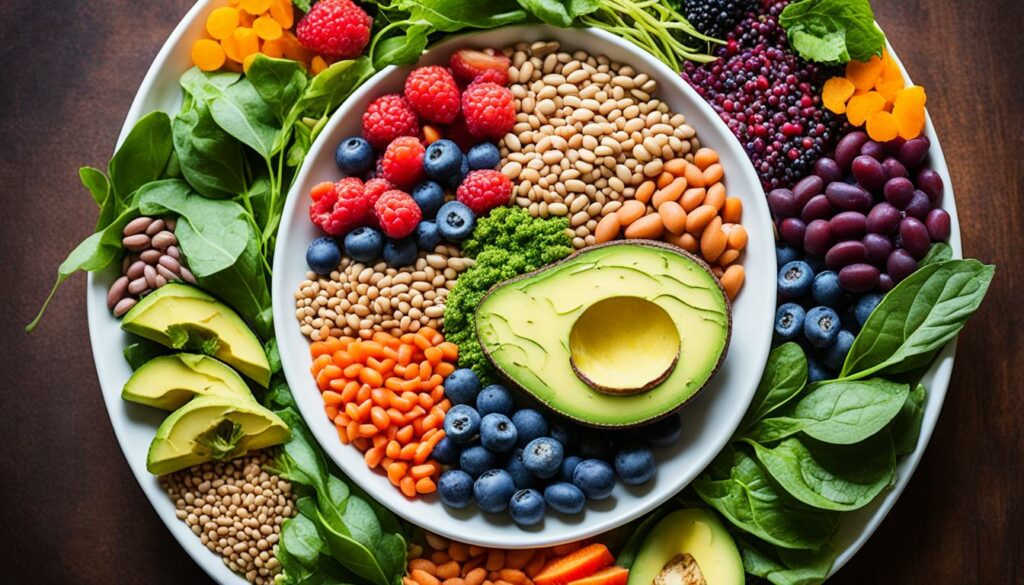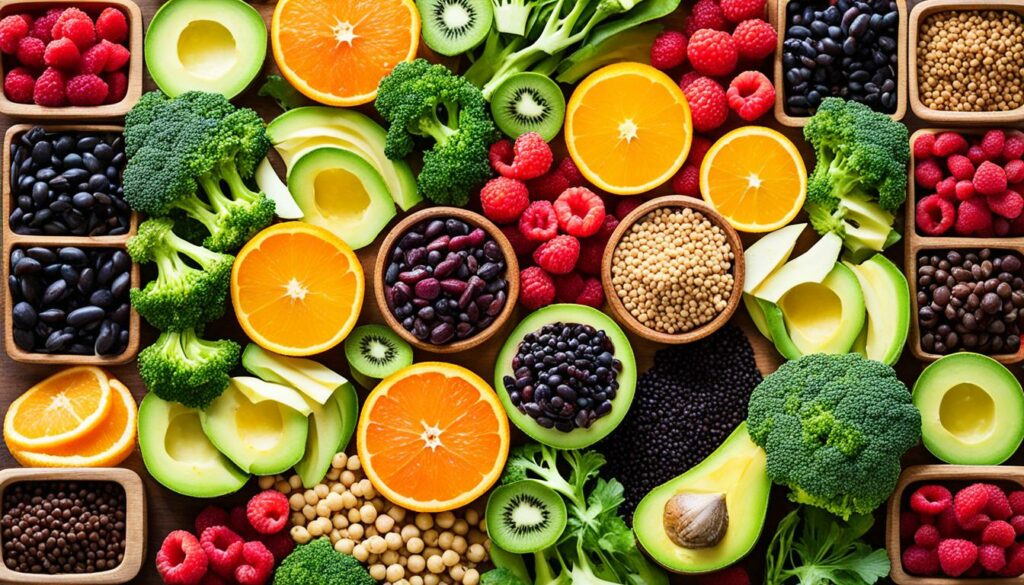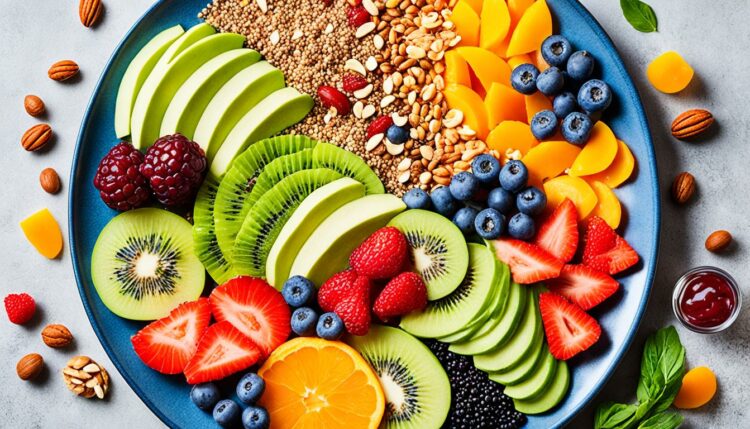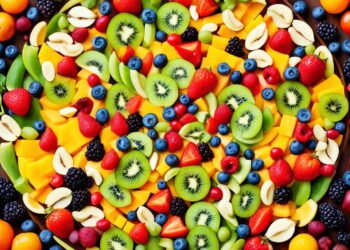Did you know that the average American only consumes about half the recommended amount of dietary fiber? If you’re among the many people who aren’t meeting their fiber needs, it’s time to make a change.
Incorporating fiber-rich foods into your diet can have a significant impact on your overall health and well-being. Not only does fiber promote regular bowel movements, but it also helps maintain bowel health, aids in weight management, and can even reduce the risk of chronic diseases.
So, what are the top 10 fiber foods that you should include in your diet? Let’s explore the best sources of fiber that can help you improve your nutrition and enjoy a healthier lifestyle.
Key Takeaways:
- Consuming enough dietary fiber is crucial for maintaining a healthy diet and overall well-being.
- A high-fiber diet can promote regular bowel movements, support bowel health, aid in weight management, and reduce the risk of chronic diseases.
- The top 10 fiber foods include beans, lentils, broccoli, berries, avocados, popcorn, whole grains, apples, dried fruits, potatoes, and nuts.
- It’s important to gradually increase your fiber intake and stay hydrated to prevent digestive discomfort.
- Incorporating a variety of fiber-rich foods into your meals and snacks can help you meet your daily fiber requirements and improve your overall fiber intake.
Now that you know the importance of fiber and the top fiber foods to include in your diet, let’s dive deeper into their benefits and discover tips for increasing your fiber intake.
The Importance of Fiber and its Benefits
Fiber plays a crucial role in various aspects of health. It is often touted for its importance in maintaining a healthy gut and promoting regular bowel movements. The consumption of fiber-rich foods supports the growth of beneficial gut bacteria, which contributes to a healthy digestive system and overall gut health.
In addition to its role in gut health, fiber can also aid in weight management. High-fiber foods provide a sense of fullness and help to curb hunger, which can be beneficial for those looking to manage their weight. Fiber-rich foods take longer to digest, helping to slow down the emptying of the stomach and promoting satiety.
Furthermore, fiber has been shown to have a positive impact on cholesterol levels. Soluble fiber, which is found in foods like oats, fruits, and legumes, can help to lower LDL (bad) cholesterol by binding to cholesterol in the digestive system and preventing its absorption into the bloodstream.
Another benefit of fiber is its ability to regulate blood sugar levels. Soluble fiber can slow down the absorption of sugar, preventing rapid spikes in blood sugar levels and promoting better blood sugar control. This can be particularly beneficial for individuals with diabetes or those at risk of developing the condition.
Research suggests that fiber may also play a role in cancer prevention. Certain types of fiber have been associated with a lower risk of colorectal cancer.
Additionally, a high-fiber diet that includes plenty of fruits, vegetables, and whole grains has been linked to a decreased risk of other types of cancer, such as breast and pancreatic cancer.
Overall, incorporating an adequate amount of fiber into your diet is essential for maintaining good health. It offers a range of benefits, from supporting gut health and weight management to regulating cholesterol levels, controlling blood sugar, and potentially reducing the risk of certain types of cancer.

| Fiber and Gut Health | Fiber and Weight Management | Fiber and Cholesterol Levels | Fiber and Blood Sugar Control | Fiber and Cancer Prevention |
|---|---|---|---|---|
| Promotes regular bowel movements | Provides a sense of fullness | Helps lower LDL cholesterol | Slows down sugar absorption | Potentially reduces the risk of certain cancers |
| Supports the growth of beneficial gut bacteria | Slows down digestion | May increase HDL cholesterol | Prevents blood sugar spikes | Linked to a lower risk of colorectal, breast, and pancreatic cancer |
Top 10 Fiber Foods to Include in Your Diet
When it comes to boosting your fiber intake, incorporating high-fiber foods into your diet is essential. These fiber-rich foods not only provide a wide range of health benefits but also add variety and flavor to your meals and snacks. Here are the top 10 fiber foods you should consider adding to your daily menu:
- Beans: Whether it’s black beans, lentils, or chickpeas, legumes are a great source of fiber. They are versatile and can be incorporated into soups, salads, or even made into delicious bean dips.
- Lentils: These small legumes are packed with fiber and can be used in a variety of dishes, including soups, stews, and salads.
- Broccoli: This cruciferous vegetable not only provides fiber but also contains essential vitamins and minerals. Steam or roast it for a nutritious side dish.
- Berries: Strawberries, blueberries, raspberries, and blackberries are not only delicious but also high in fiber. Enjoy them fresh or add them to smoothies, yogurts, or salads.
- Avocados: Not only are avocados creamy and delicious, but they also offer a good amount of fiber. Spread avocado on toast or add it to salads for a nutritious boost.
- Popcorn: Believe it or not, popcorn can be a healthy and satisfying snack option. Air-popped popcorn is high in fiber and low in calories.
- Whole Grains: Opt for whole grains like quinoa, brown rice, and whole wheat bread to increase your fiber intake. These grains are more nutritious and provide more fiber than refined grains.
- Apples: An apple a day not only keeps the doctor away but also provides a good amount of fiber. Enjoy them as a snack or add them to salads and desserts.
- Dried Fruits: Foods like dates, raisins, and prunes are concentrated sources of fiber. They make for a convenient and delicious snack on the go.
- Potatoes: Don’t discard the skins! Potato skins are rich in fiber. Enjoy baked potatoes with the skin on or make homemade potato wedges for a fiber-filled side dish.
- Nuts and Seeds: Almonds, chia seeds, and flaxseeds are excellent sources of fiber. Add them to oatmeal, yogurt, or salads for an extra nutritional boost.
By incorporating these top 10 fiber foods into your diet, you can enhance your fiber intake and enjoy the numerous health benefits that come with it.
They not only provide fiber but also offer a variety of vitamins, minerals, and antioxidants to support your overall nutrition. Remember to include a mix of these fiber-rich foods in your meals and snacks for a well-rounded and healthy diet.

Tips for Increasing Fiber Intake
If you’re looking to increase your fiber intake, there are several strategies you can implement. It’s important to note that gradually increasing fiber and staying hydrated can help prevent digestive discomfort. Here are some tips to help you consume more fiber:
- Start by adding high-fiber foods to your meals and snacks. Incorporating fiber-rich foods like fruits, vegetables, whole grains, and legumes can significantly boost your fiber intake. For example, enjoy a bowl of oatmeal with berries for breakfast or snack on carrot sticks with hummus.
- Gradually increase the portion sizes of high-fiber foods. This allows your body to adjust to the increased fiber intake. For instance, if you’re adding more whole grains to your diet, slowly increase the amount of whole grain pasta or brown rice you consume over time.
- Consider using fiber supplements. While whole foods are generally the best sources of fiber, supplements can be useful for meeting your fiber goals. Be sure to choose a reputable brand and follow the recommended dosage. Speak to your healthcare provider before starting any new supplements.
- Stay hydrated. Fiber needs water to move efficiently through the digestive system and prevent constipation. Aim to drink at least 8 glasses of water per day. You can also increase your fluid intake by consuming herbal teas, infused water, and eating water-rich fruits and vegetables like cucumbers and watermelon.
By following these tips, you can gradually increase your fiber intake and reap the many health benefits associated with a fiber-rich diet.
| Fiber-Rich Foods | Fiber Content per Serving (g) |
|---|---|
| 1 cup of raspberries | 8 |
| 1 medium avocado | 9 |
| 1 cup of whole wheat pasta | 6 |
| 1 cup of cooked lentils | 15.6 |
| 1 cup of broccoli | 5.1 |
| 1 medium pear | 5.5 |
| 1 ounce of almonds | 3.4 |
Conclusion
A fiber-rich diet plays a crucial role in maintaining good health and overall well-being. By incorporating high-fiber foods into your daily meals and snacks, you can improve your fiber intake and enjoy the numerous benefits associated with a fiber-rich diet.
Dietary fiber not only supports digestive health but also promotes weight management by providing a feeling of fullness and aiding in the regulation of blood sugar levels. Additionally, a fiber-rich diet can help reduce the risk of chronic diseases such as heart disease and certain types of cancer.
To improve your fiber intake, gradually increase your consumption of foods such as beans, lentils, broccoli, berries, avocados, whole grains, apples, dried fruits, potatoes, and nuts. Remember to stay hydrated by drinking enough water, as fiber works best when combined with adequate hydration.
Make fiber a priority in your diet and experience the positive impact it can have on your overall health. Incorporating a variety of high-fiber foods into your meals and snacks is a simple and effective way to enhance your fiber intake and optimize your well-being.
FAQ
What are the top 10 fiber foods?
The top 10 fiber foods include beans, lentils, broccoli, berries, avocados, popcorn, whole grains, apples, dried fruits, potatoes, and nuts.
Why is fiber important and what are its benefits?
Fiber is important for maintaining good health and has numerous benefits. It supports digestive health, promotes weight management, regulates blood sugar levels, and reduces the risk of chronic diseases.
How does fiber affect gut health?
Fiber promotes regular bowel movements and supports the growth of beneficial gut bacteria, enhancing gut health and microbiome diversity.
Can fiber help with weight management?
Yes, fiber provides a sense of fullness, slows down digestion, and aids in weight management.
Does fiber play a role in lowering cholesterol levels?
Yes, consuming high-fiber foods can help lower cholesterol levels and promote heart health.
Can fiber help regulate blood sugar levels?
Yes, fiber slows down the absorption of sugar, which can help regulate blood sugar levels and reduce the risk of diabetes.
Does fiber have any impact on cancer prevention?
Studies suggest that a high-fiber diet may help reduce the risk of certain types of cancer, including colorectal cancer.
How can I increase my fiber intake?
You can increase your fiber intake by gradually incorporating high-fiber foods into your meals and snacks and ensuring you stay hydrated.
Are there any tips for consuming more fiber?
Yes, it’s recommended to start by adding small amounts of high-fiber foods to your diet and gradually increase the portion sizes. Additionally, fiber supplements can be used to help meet your fiber goals.
Are there any precautions to consider when increasing fiber intake?
It’s important to increase fiber intake gradually and drink enough water to prevent any digestive discomfort.
Are there any other sources of fiber besides whole foods?
While whole foods are generally the best sources of fiber, fiber supplements can also be used to help meet your fiber goals.




